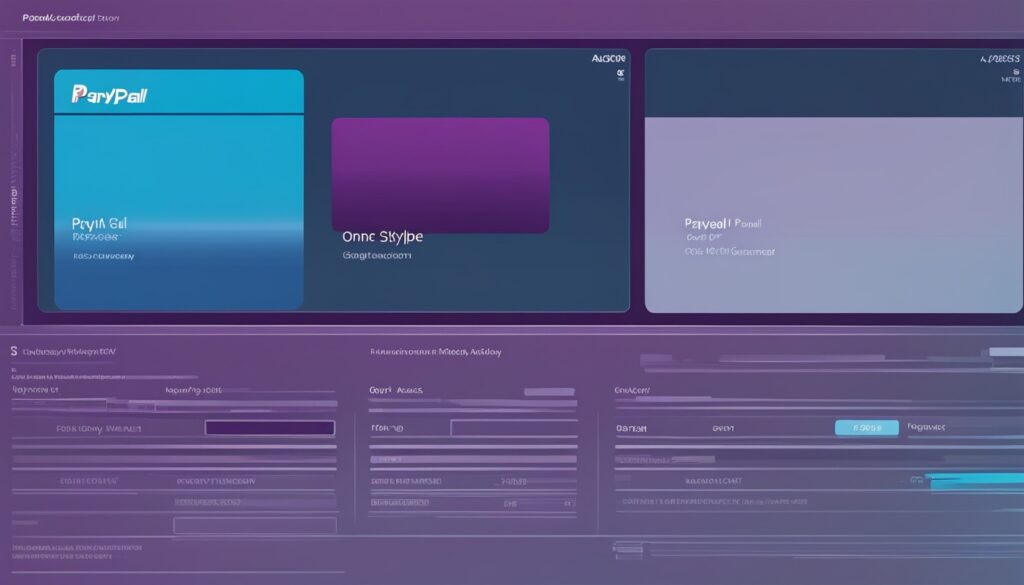Did you know Stripe handles $35 billion in payments yearly? PayPal, on the other hand, processes over $1 trillion in transactions. These two giants are top choices for businesses big and small. But which one is best for you? This detailed look will guide you in picking the right payment processing partner for your business.
Key Takeaways:
- Stripe offers a simpler, more transparent pricing model, while PayPal’s fee structure can be more complex.
- Stripe supports a wider range of payment methods and currencies, providing more flexibility for international transactions.
- PayPal is a well-established brand with higher trust and familiarity among consumers, but Stripe excels in advanced fraud protection.
- Stripe’s customizability and developer-friendly features make it a better choice for tech-savvy businesses, while PayPal is easier to set up for smaller enterprises.
- Both Stripe and PayPal offer robust payment processing solutions, but the right choice depends on your business’s specific needs and preferences.
Introduction to Payment Gateways
In the online shopping world, a payment gateway is key for safe transactions between your business and customers. It acts as a middleman, handling payments and keeping financial info safe. This makes buying from you smooth and trustworthy.
What is a Payment Gateway?
A payment gateway is a software that links your website to the payment processing system. It sends customer payment info, like credit card numbers, safely to the payment processor for approval. These gateways are vital for online payment processing and ecommerce payment solutions. They add a security layer that builds trust with your customers.
Difference Between Payment Gateways and Payment Processors
Payment gateways and processors work together but have different jobs. Processors handle the payment’s backend, linking merchants to networks like Visa and Mastercard. Gateways connect the merchant’s site to the processor, ensuring secure transactions at checkout.
Think of gateways as the online cash register. They gather and send customer payment info to the processor. The processor checks the transaction and moves the money to the merchant. This setup makes payment processing smooth for both businesses and shoppers.
| Payment Gateway | Payment Processor |
|---|---|
| Connects the merchant’s website to the payment processing infrastructure | Handles the backend processing of payments, connecting merchants with credit card networks |
| Provides a secure checkout experience for customers | Verifies transactions and transfers funds to the merchant’s account |
| Examples: Stripe, PayPal, Authorize.net | Examples: Fiserv, Chase Paymentech, First Data |

Overview of Stripe and PayPal
Stripe: A Developer-Friendly Payment Gateway
Stripe is an online payment service that acts as both a stripe payment gateway and a payment processor. It started in 2011 and is quickly becoming popular in the ecommerce world. It now holds 15% of the global market for payment processing software.
Stripe was made with developer-friendly payment processing in mind. It offers many customizable tools and APIs for adding payment processing to your website or ecommerce platform. This makes Stripe great for mid-to-large businesses that can use its advanced features. Features include a customizable checkout experience and easy ecommerce integrations.
PayPal: A Household Name in Online Payments
PayPal has been around since 1998 and is a well-known name in ecommerce payments. It works as both a payment gateway and a payment processor. Businesses of all sizes, from small to medium, use PayPal for their payments.
PayPal is easy to set up, making it perfect for small businesses or those without a lot of tech know-how. It has 50% of the global market for payment processing.
| Feature | Stripe | PayPal |
|---|---|---|
| Global Reach | Stripe processes payments from 195 countries in 135 currencies. | PayPal accepts payments from over 200 countries in 120 currencies. |
| Payment Methods | Stripe accepts over 100 payment methods, including Apple Pay, Google Pay, and many digital wallets. | PayPal offers a more limited range of payment methods compared to Stripe. |
| Integrations | Stripe has 610 integrations available, surpassing PayPal’s integration options. | PayPal has a smaller number of integrations compared to Stripe. |
| Customer Support | Stripe provides 24/7 support via phone and live chat. | PayPal’s support is available from Monday to Friday, 8:00 a.m. to 8:00 p.m. Central time. |
“Stripe is a better fit for mid-to-large sized businesses that have the technical resources to take advantage of its advanced features, including a customizable checkout experience and seamless ecommerce integrations.”

Pricing and Fee Structures
Payment gateways have different pricing and fee structures. Let’s look at Stripe and PayPal and how they charge.
Stripe’s Simple Pricing Model
Stripe has a simple pricing model. It charges a flat rate of 2.9% plus $0.30 per transaction for all major credit cards. This rate doesn’t change, no matter the card type. There are no monthly fees, minimums, or interchange costs.
Stripe also offers a lower rate of 2.9% + $0.05 for micropayments (transactions under $10). The chargeback fee is $15 per dispute.
PayPal’s Complicated Fee Schedule
PayPal has a more complex fee schedule. It has different fees for various transaction types. The standard rate is 2.9% plus $0.30 per transaction. But, PayPal charges more for micropayments (5% plus $0.05) and a $20 chargeback fee.
PayPal’s fees can be harder to understand than Stripe’s simple pricing model.
| Pricing Factors | Stripe | PayPal |
|---|---|---|
| Transaction Fee | 2.9% + $0.30 | 2.9% + $0.30 |
| Micropayment Fee | 2.9% + $0.05 | 5% + $0.05 |
| Chargeback Fee | $15 | $20 |
| Monthly Fees | None | Varies |
In summary, Stripe’s flat rate transaction fees and simple pricing are easy to understand. PayPal’s fees are more complex, which might be harder for some businesses to manage.

Payment Methods and Integrations
Online payments offer many options for businesses. Stripe and PayPal are two top choices that support different payment types and integrate well with ecommerce. Let’s see what they offer.
Payment Types Accepted by Stripe
Stripe accepts all major credit cards, debit cards, and many digital wallets. This includes Apple Pay, Google Pay, and Microsoft Pay. It also works with ACH payments, giving businesses a broad range of payment options.
With over 450 ecommerce integrations, Stripe suits businesses big and small. Its API is easy for developers to use, making payments smooth for customers.
Payment Options with PayPal
PayPal takes all major credit cards and debit cards. It also has Venmo and PayPal Credit for other payment choices.
PayPal is known and trusted by many online shoppers. But, it doesn’t offer as many payment options as Stripe. This might limit the ways you can take payments.
Security and Fraud Protection
Online payments need to be secure and protect against fraud. Stripe and PayPal are both PCI compliant. This means they meet the high security standards set by the Payment Card Industry. But Stripe goes further with Stripe Radar. This tool uses machine learning to spot and stop suspicious transactions right away. This makes Stripe a top choice for businesses worried about fraud and chargebacks.
Stripe’s Advanced Fraud Detection
Stripe Radar uses machine learning to check transaction patterns for fraud. It learns from billions of transactions worldwide. This helps Stripe Radar catch and stop suspicious transactions before they happen. This keeps businesses safe from fraud and chargebacks.
Stripe also has other security features like:
- Tokenization to replace sensitive payment data with safe tokens
- PCI compliance for secure handling of customer data
- Secure encryption like SSL and TLS to keep data safe during transfer
- Address Verification Service (AVS) to check billing addresses and fight fraud
These security features and fraud detection tools make Stripe a reliable choice for businesses. They help protect online payments and keep customers’ trust.
“52% of companies with global annual revenues exceeding $10 billion experienced fraud in the past 24 months, with 18% losing over $50 million in their most disruptive incident.”
| Fraud Impact | Large Companies | Smaller Companies |
|---|---|---|
| Experienced Fraud | 52% | 38% |
| Lost Over $50 Million | 18% | N/A |
| Lost Over $1 Million | N/A | 22% |
International Transactions and Currency Support
When you want to take payments from all over the world, the payment gateway’s flexibility is key. Stripe and PayPal are top choices for this, each with their own strengths in handling global payments.
Stripe’s Extensive Currency Support
Stripe is a top pick with support for over 135 different currencies. This is great for businesses that deal with customers from many countries. Stripe has a clear fee plan. It charges a low 1% extra for payments across borders and currency changes. This makes it a smart choice for businesses in many markets.
PayPal’s Global Reach
PayPal is huge worldwide, available in over 200 countries and supporting 25 currencies. This wide reach lets businesses take payments from customers everywhere. PayPal is a top choice for businesses with customers all over the globe.
| Payment Gateway | Supported Currencies | International Presence |
|---|---|---|
| Stripe | 135+ | 135+ countries |
| PayPal | 25 | 200+ countries/regions |
Stripe and PayPal both offer strong solutions for international payments and currency support. The best choice depends on your business’s needs and where your customers are.
Ease of Setup and Use
Setting up a payment gateway can be different for everyone. Stripe is great for developers because it has strong tools and an API. This lets businesses create a checkout that fits their brand perfectly. But, you’ll need a team of skilled developers to make it work.
PayPal is easier to use and set up. It sends customers to the PayPal site to finish their purchase. This makes it good for businesses that don’t have many tech experts. Even though PayPal doesn’t let you customize as much as Stripe, it’s quicker to start using.
Stripe’s Developer-Friendly Setup
- Robust developer tools and powerful API for highly customized checkout
- Requires technical expertise and access to a team of developers
- Allows for a tailored payment experience that aligns with your brand
PayPal’s Straightforward Implementation
- Off-page checkout process for a more user-friendly experience
- Minimal coding required, making it accessible for businesses without extensive technical resources
- Faster setup process, but with more limited customization options
Choosing between Stripe and PayPal depends on your business’s tech skills, how much you want to customize, and how important a smooth checkout is for your customers.
Which Payment Gateway Is Right for You?
Choosing between Stripe and PayPal depends on your business’s specific needs. Stripe is great for big businesses that can use its advanced features. PayPal is better for small businesses or startups that want something easy to use.
Think about these factors when picking a payment processor:
- Business size and technical capabilities: Stripe is for businesses with tech skills. It has advanced features. PayPal is easy to start and use, perfect for small businesses or those with little tech know-how.
- Pricing and fee structures: Stripe charges a simple 2.9% + 30¢ per transaction. PayPal’s fees can be complex, with extra charges for international payments and currency changes.
- Payment method support: Both Stripe and PayPal support many payment types. But, the options depend on your business and what your customers like.
The choice between Stripe and PayPal is about what your business needs. Look at your payment processing requirements and pick the best option for your goals and budget. This way, you can make a smart choice that helps your business succeed online.
Customer Support and Resources
Choosing the right payment gateway can greatly depend on the support and resources offered. Stripe and PayPal both provide strong support, but they differ in some ways.
Stripe’s 24/7 Support Options
Stripe is known for its 24/7 customer support. This means businesses can get help anytime through phone and live chat. This is great for companies facing technical issues or needing help with Stripe’s advanced features.
Stripe also has a detailed knowledge base and community resources. These tools help merchants solve problems and find answers quickly.
PayPal’s Customer Service Channels
PayPal offers support through email, live chat, a knowledge base, and community forums. But, phone support is only available during regular hours. This might not work for businesses needing help at any time.
When choosing between Stripe and PayPal, think about what your business needs. If you want support any time and a wide knowledge base, Stripe might be best. But if you’re okay with help during regular hours, PayPal could be enough.
Conclusion
Stripe and PayPal are both great for businesses, each with their own strengths. Stripe is perfect for big companies that need advanced features and strong fraud protection. It also lets businesses customize their checkout process.
PayPal is great for small businesses or startups. It’s easy to use and has a well-known brand. This makes it a good choice for those who want a simple way to accept payments online.
When picking between Stripe and PayPal, think about what your business needs. Consider things like how you handle payments, your tech skills, and what matters most to you. This will help you find the best payment gateway for your business.
Both Stripe and PayPal offer secure and rich payment gateway services. They help you manage online payments smoothly. By choosing the right one, you can make your payment process easier, save time, and focus on giving your customers a great experience. This can lead to more sales and growth for your business.
FAQ
What is a payment gateway?
A payment gateway is a service that helps your website and customers make payments safely. It makes sure customers can buy things on your site without worrying about fraud.
What is the difference between a payment gateway and a payment processor?
Payment gateways connect your business with payment processors. These processors help with credit card payments. Your business doesn’t directly connect with Visa or Mastercard. So, processors act as a middleman to send payment info to the bank.
How does Stripe differ from PayPal?
Stripe is an online payment service that acts as both a gateway and a processor. PayPal does the same but is more geared towards small businesses and startups. Stripe is better for big businesses that need lots of technical help.
What are the key features and pricing of Stripe and PayPal?
Stripe charges a simple 2.9% plus $0.30 per transaction. PayPal has different fees for different types of transactions. Stripe offers more payment types and integrations. PayPal is bigger globally and has more customers.
How do Stripe and PayPal differ in terms of security and fraud protection?
Both Stripe and PayPal follow strict security rules. Stripe goes further with Stripe Radar, a tool that uses machine learning to stop fraud right away.
Which payment gateway is better for international transactions?
Stripe is great for international payments, supporting over 135 currencies. It has low fees for payments across borders. PayPal works in over 200 countries and supports 25 currencies, making it very global.
How difficult is it to integrate Stripe and PayPal with my website?
Adding Stripe to your site needs more tech skills than PayPal. Stripe has strong tools for developers and a detailed API for a custom checkout. PayPal is easy to set up and use, needing little coding.
Which payment gateway offers better customer support?
Stripe has 24/7 support by phone and chat, plus lots of online resources. PayPal also has support by email, chat, and a knowledge base, but phone help is only during work hours.
Which payment gateway is the best fit for my business?
Choosing between Stripe and PayPal depends on what your business needs. Stripe is great for big businesses needing advanced features and customization. PayPal is easier to use and better for small businesses or startups that value simplicity.



